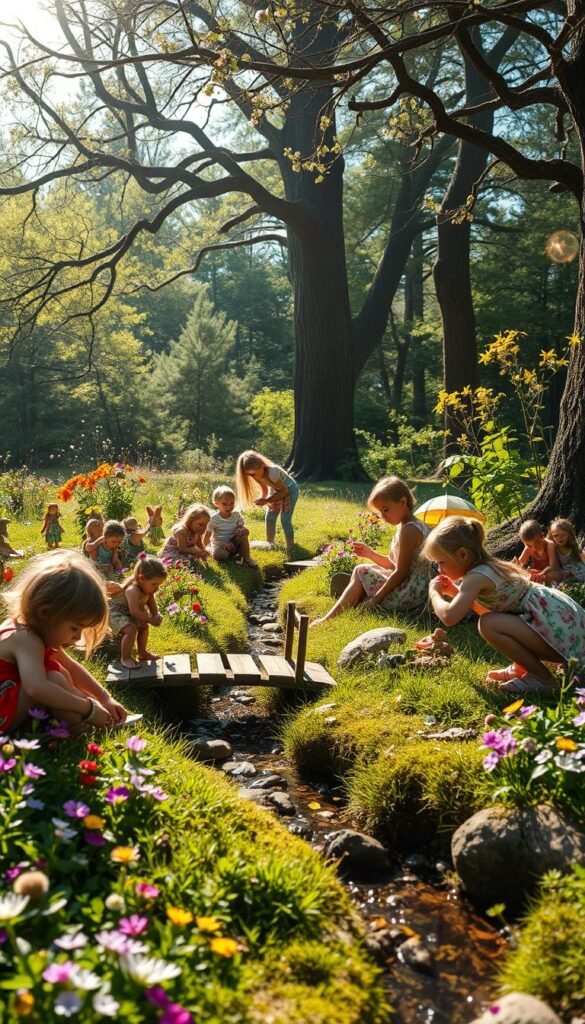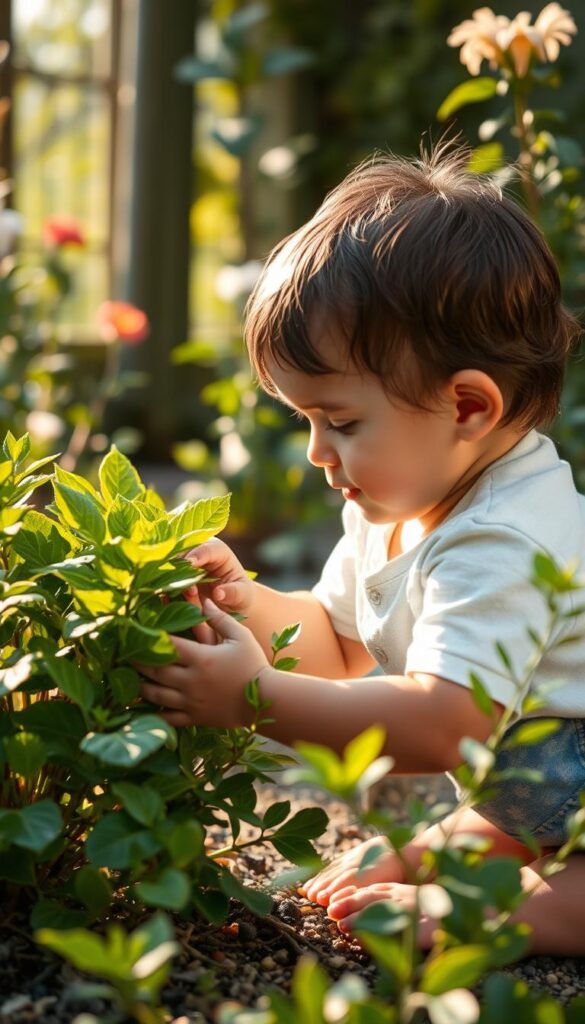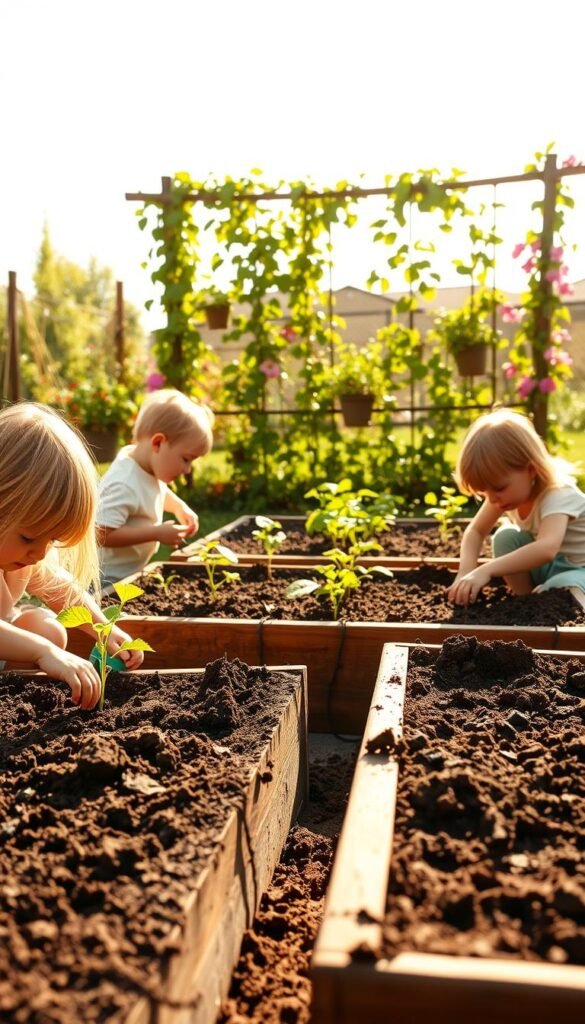Watching little hands dig into soil creates more than just dirty fingernails – it plants seeds of wonder. Simple outdoor experiences help young explorers understand life cycles while developing motor skills and scientific thinking. Best part? You don’t need acres of land to cultivate these moments.
A recycled container garden or windowsill herb pot becomes your child’s first laboratory. As they sprinkle seeds and mist sprouts, they’ll discover how sunlight and water transform tiny specks into living plants. These hands-on lessons teach cause-and-effect relationships better than any textbook.
Through daily care routines, kids naturally learn responsibility. They’ll beam with pride seeing their strawberry plant flower or carrot tops peek through dirt. That gasp when they spot their first ladybug? Pure magic – and a perfect chance to discuss ecosystems.
Urban families can adapt these nature adventures easily. Try growing microgreens in takeout containers or creating a fairy garden with found objects. Each activity meets children where they are developmentally, turning simple tasks into confidence-building wins.
These shared experiences do more than grow plants – they nurture family bonds and environmental awareness. You’re not just planting basil seeds together. You’re cultivating curiosity that will blossom for years to come.
Welcome to Your Child’s Garden Adventure
A tiny hand cradling a sunflower seed holds endless possibilities. Through simple garden tasks, young minds discover nature’s rhythms while building foundational abilities. Let’s explore how these earthy experiences shape growth beyond plants.
Why Gardening Sparks Curiosity
Every scoop of soil becomes a science lesson. When roots push through dirt or leaves unfurl toward light, children see biology in action. These moments spark questions about seasons, bugs, and plant needs – perfect for engaging lesson plans that stick better than flashcards.
Building Confidence and Motor Skills
Pinching seeds strengthens finger muscles needed for writing. Pouring water without spilling teaches control. As kids master these tasks, their pride blooms alongside marigolds. One parent shared: “After three weeks, my daughter could button her coat alone – those seed trays worked magic!”
| Skill Developed | Garden Activity | Real-World Benefit |
|---|---|---|
| Fine Motor Control | Seed Spacing | Improved pencil grip |
| Pattern Recognition | Leaf Shape Sorting | Early math readiness |
| Responsibility | Daily Watering | Task completion habits |
These hands-on experiences create neural pathways through sensory input. Cool soil textures, earthy scents, and rustling leaves engage multiple senses at once. Best of all? Every success – from sprouted beans to harvested herbs – builds lasting self-assurance.
Discovering the Benefits of Gardening for Preschoolers

Nurturing plants does more than grow flowers—it cultivates young minds. Through earthy adventures, children gain tools for growth that extend far beyond garden beds. Let’s explore how tending greenery shapes both cognitive abilities and emotional well-being.
Boosting Learning and Development
Gardening becomes a living classroom where lessons take root naturally. When your child measures soil depth or counts petals, they’re practicing early math concepts without worksheets. Science discoveries unfold daily as seedlings stretch toward light and rain droplets bead on leaves.
You’ll notice improved focus during storytime after peaceful potting sessions. The rhythmic nature of watering and weeding creates calming patterns that help reduce anxiety. One teacher observed: “Students who garden show 40% longer attention spans during group activities.”
Teamwork blossoms when multiple hands work together. Sharing tools and comparing plant progress teaches valuable communication skills. These interactions build confidence—especially when kids proudly present their harvests.
Physical development thrives through building fine motor skills during precise tasks like seed placement. Strengthened finger muscles from pinching soil lead to better pencil grips. Even simple actions like carrying watering cans enhance coordination.
Environmental stewardship grows naturally through composting lessons and ladybug observations. Your preschooler will grasp ecosystem connections while protecting their plant “friends” from pests. These experiences create lasting respect for nature’s delicate balance.
Creating a Safe and Accessible Garden Space

Transform any corner into a wonder-filled classroom where safety meets discovery. The right setup lets young explorers focus on nature’s magic without unnecessary risks. Let’s build an environment where curiosity grows freely.
Selecting the Perfect Garden Spot
Start by chasing sunlight – most plants thrive with six daily hours. Look for flat ground free from sharp rocks or tree roots. Avoid areas near thorny bushes or unknown wild plants. Clear pathways matter more than you think – 24-inch wide walkways prevent tripping during excited sprout checks.
Choosing Child-Friendly Tools and Materials
Opt for tools sized for small grips – lightweight trowels and narrow rakes work best. Plastic watering cans with two handles give better control. One parent noted: “Our 4-year-old manages her mini shovel better than I handle mine!”
| Feature | Child-Safe Solution | Key Benefit |
|---|---|---|
| Sun Exposure | South-facing spaces | Optimal plant growth |
| Soil Quality | Organic potting mix | Non-toxic nutrients |
| Pathways | Mulch-covered trails | Slip prevention |
| Tools | Color-coded sets | Easy identification |
| Protection | UV-blocking hats | Sun safety |
Always test soil drainage before planting – soggy dirt frustrates little gardeners. Cotton gloves with rubber grips protect hands while allowing tactile experiences. Remember: non-toxic fertilizers keep exploration safe when curious fingers explore textures.
5 Gardening Activities for Preschoolers That Spark Curiosity

Little fingers pressing seeds into earth begin a journey of discovery. These tactile projects turn ordinary afternoons into science experiments, with nature as both teacher and playground. Start with fast-sprouting varieties to maintain excitement – beans and sunflowers work wonders.
Hands-On Projects That Inspire Exploration
Bean sprouting stations captivate young learners. Use clear cups lined with damp cotton balls to showcase root development. Kids cheer when white tendrils appear overnight – a perfect moment to discuss how plants “drink” water.
| Activity | Materials Needed | Learning Outcome |
|---|---|---|
| Window Germination | Clear cups, cotton, beans | Understanding root systems |
| Sunflower Journaling | Seeds, ruler, notebook | Measurement skills |
| Herb Sensory Pots | Mint/basil seeds, textured soil | Exploring plant textures |
Create growth trackers using simple drawings or photo collages. One parent shared: “My son checks his sunflower chart before breakfast – he’s obsessed with counting new leaves!” This daily ritual builds observation skills while teaching responsibility.
Space seeds carefully using finger-width measurements. Tiny hands learn precision while placing each potential plant. Quick results keep motivation high – radishes often sprout in just 4 days. These successes prepare young minds for more complex projects later.
Inspiring Creativity with Themed Garden Projects

Tiny hands arranging pebbles and petals craft more than gardens—they build imaginary worlds. Themed projects turn outdoor spaces into creative playgrounds where learning blooms through play. These activities merge artistic expression with nature exploration, helping young minds grow alongside their plants.
Designing Fairy Gardens and Sensory Herb Beds
Transform a shallow pot into an enchanted realm using moss, miniature flowers, and twig furniture. Children love placing fairy doors against tree roots or creating pebble pathways. This project teaches spatial awareness as kids balance scale and color in their designs.
Herb beds become sensory wonderlands when you include fuzzy lamb’s ear and spicy basil. Let little fingers crush mint leaves to release fresh scents. One parent remarked: “My son now identifies thyme by smell alone—he calls it ‘pizza plant’!”
Personalizing Garden Art and Crafts
Hand-painted rocks make cheerful plant markers. Use weather-resistant acrylics to decorate terracotta pots with rainbow patterns. These crafts develop color recognition while protecting delicate seedlings.
Create wind chimes from recycled spoons and seashells. Hang them near bean poles to spark conversations about sound and motion. Through these projects, children learn that gardens aren’t just for growing—they’re living art studios.
Interactive Lessons: Integrating Learning and Natural Observation

Your backyard transforms into a living science lab when young explorers engage with nature’s rhythms. By blending structured activities with open-ended discovery, you create opportunities for meaningful connections with the environment.
Observing Plant Growth and Wildlife
Turn garden exploration into detective work with customized scavenger hunts. Create checklists featuring smooth stones, fuzzy stems, or ladybug sightings. As your child checks off items, discuss how worms aerate soil or why bees visit flowers. These interactions build awareness of ecosystem relationships while sharpening observation skills.
Simple bird feeders made from pinecones and seed become wildlife magnets. Hang them near windows to study feather patterns and feeding habits. One parent noted: “My daughter names every sparrow that visits—she’s learned patience through quiet watching.”
Encourage daily plant inspections using a growth chart. Measure sprout heights with ribbon lengths or take weekly photos. Your child will notice how leaves follow sunlight and roots thicken over time. This hands-on tracking makes abstract concepts like photosynthesis tangible.
Balance guided activities with free exploration. Let kids poke holes in soil to test drainage or compare shaded vs. sunny growth areas. These experiments nurture scientific thinking—and often lead to joyful exclamations when discoveries unfold.
Tips for Nurturing Patience, Responsibility, and Play
Every droplet from a watering can holds potential for growth – both in plants and young minds. Blending care routines with playful discovery helps children build essential skills while connecting with nature’s rhythms. These strategies turn daily garden time into meaningful learning moments.
Engaging Activities to Teach Life Skills
Transform watering duty into a counting game. Ask your child to give each plant “five sips” while practicing numbers. Create a weather chart where they track rain patterns and sunlight hours. These simple tasks teach responsibility through consistent care while sneaking in math practice.
Try a “plant doctor” role-play session. Kids inspect leaves for spots and measure stem growth with ribbon strips. One parent shared: “My son now reminds me to check our tomatoes every morning – he takes his doctor job seriously!” This playful approach makes maintenance feel like adventure.
Encouraging Routine Garden Care
Establish a daily check-in ritual. Let little fingers test soil moisture and report findings. Use color-coded sticks to mark plants needing attention. Consistent routines build patience as children witness gradual changes over weeks.
Keep tools accessible in a designated “helper station.” Miniature gloves and personalized watering cans empower kids to take ownership. Celebrate small wins – like remembering to refill the birdbath – with high-fives or a victory dance. These joyful moments reinforce lasting habits.






